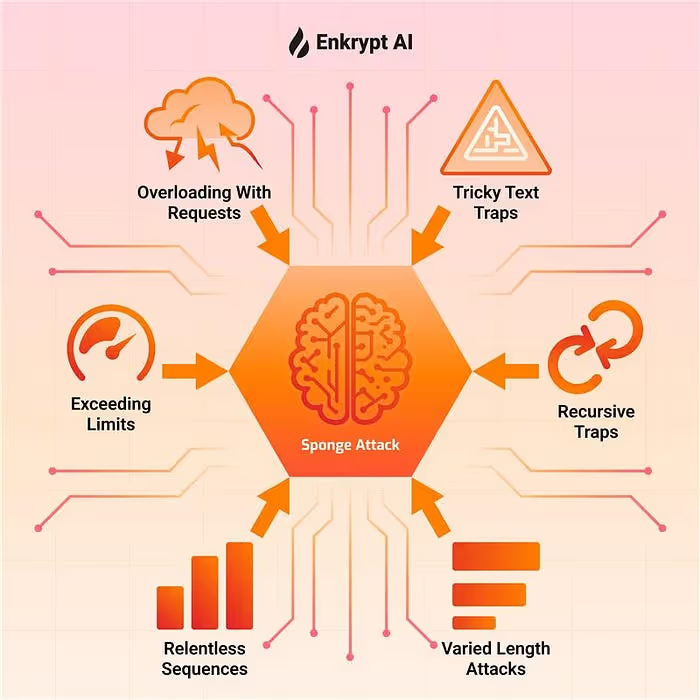The Hidden Threat: What Is a Sponge Attack?
A sponge attack targets your AI application’s resource usage — CPU, memory, inference tokens — without delivering any valuable output. Like a Denial-of-Service (DoS), but focused on the model itself, these attacks can cause:
- Resource exhaustion leading to timeouts or crashes
- Increased cloud costs through wasted compute
- Service degradation for legitimate users
They exploit the model’s heavy consumption characteristics — like exploding context windows or unchecked generation loops — to bring systems to a halt.
LLMs are particularly vulnerable because their resource usage scales with input and output size .

Why Sponge Attacks Matter
LLMs power a growing number of critical applications — from healthcare and legal assistants to voice agents and compliance tools.
Yet sponge attacks aren’t just theoretical; they’re becoming a real-world threat:
- Financial strain: Faulty inputs can artificially inflate inference costs.
- UX degradation: Slow or unresponsive services frustrate users.
- No need for jailbreaks: These attacks use benign inputs, not prompts that bypass filters.
- Missed by standard tests: Conventional code-based testing often overlooks these vectors .
Research shows sponge inputs can multiply energy consumption and latency by 10–200× . It’s not just inefficiency — it’s unpredictable system behavior and escalating operational risk.

Research & Defense Strategies
Foundational Research
- “Sponge Examples: Energy-Latency Attacks on Neural Networks” demonstrates how crafted inputs spike energy use and delays across tasks.
- OWASP LLM Top‑10 explicitly lists Model Denial of Service (LLM04) as a major risk.
- AutoDoS and P‑DoS studies show that even black-box LLMs can be forced into extreme output loops.
Mitigation Tactics
- Model pruning reduces vulnerability surface by constraining resource usage.
- Prompt length limits, rate limiting, and generation caps prevent runaway inference.
- Sponge-specific guardrails detect and block input patterns prone to resource exhaustion.
How Enkrypt AI Secures Your System
Enkrypt AI offers integrated defense through:
Automated Red Teaming for Sponge Attacks
Issue “sponge tests” directly within the platform. It generates adversarial inputs (e.g., “hello” repeated 50K times) to simulate real-world abuse — no setup required.
Visual Risk Reporting
View live results: which attacks succeeded, where CPU/token usage spiked, and how this impacts your service.
Built-in Guardrails
Apply sponge detection logic to automatically block excessive or looping inputs at runtime — before they consume system resources.
Ease of Use
From test to mitigation in minutes, not weeks — no rewrites, no complex integration, just actionable protection.
Watch the Demo Here:
Demo Recap
In our walkthrough, we:
- Viewed a typical sponge attack (repeating “hello” 50K+ times)
- Detected its resource drain via red teaming
- Applied guardrails to instantly block it
This end-to-end process showcases how Enkrypt AI protects your AI from resource exhaustion — preserving availability, performance, and cost predictability.
Final Thoughts
AI applications must be robust against both “clever” attacks and the mundane ways they waste resources. Sponge attacks pose a real threat to uptime, cost management, and user experience — even without malicious intent.
With Enkrypt AI, teams gain proactive testing, system-level insight, and automated protection against this growing class of AI DoS attacks.
Ensure your AI is not just functional — make it resilient.
Learn More
- 🧠 Dive deeper on OWASP LLM Top‑10: “Model Denial of Service (LLM04)”
- 📘 Read research on Sponge Examples in LLMs
- 🚀 Try red teaming and sponge guardrails at Enkrypt AI
Reach out if you’d like an AI expert, slide deck, or demo on sponge protection and LLM resilience.







